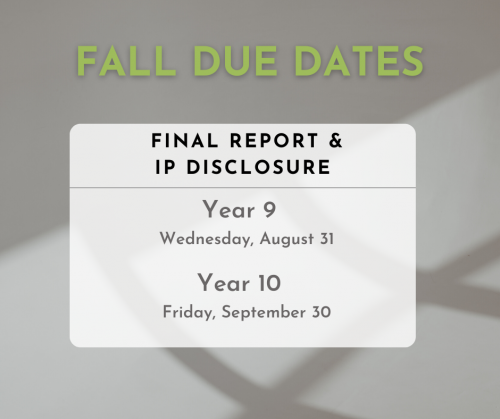WELCOME TO CVDI
* About CVDI
* State of the Center
* University Partners
* Industry Partners
* Personnel
* Related Publications
* Recognition
* Frequently Asked Questions
* Contact Us
CVDI WIKI NAVIGATION
* Project Pages
* Meeting Pages
* CVDI Calendar
* University Pages
* IAB Pages
* Marketing Material
* Reports and Documents
* Meeting Notes
User Tools
Sidebar
NEWS
Save the Date: Fall 2022 IAB Meeting is November 9
Fall 2022 Due Dates

Spring 2022 Industry Advisory Board Meeting is April 28 & 29
The meeting is April 28 & 29 hosted by the University of Louisiana at Lafayette. The hybrid meeting offers in-person and remote options. CVDI holds bi-annual progress meetings for industry members, researchers, and students to review current research projects, network and plan for the future. Visitors interested in membership are welcome to attend if they are willing to sign a non-disclosure agreement. Email iriconnect@louisiana.edu for more information about visiting a meeting with a signed nondisclosure agreement.
Fall 2021 Industry Advisory Board Meeting is November 17 in Charlotte, NC
June 23, 2021
The Fall 2021 Industry Advisory Board meeting is November 17, hosted by the University of North Carolina at Charlotte. The hybrid meeting offers in-person and remote options if your travel is restricted due to the COVID-19 pandemic. CVDI holds bi-annual progress meetings for industry members, researchers, and students to review current research projects, network and plan for the future. Visitors interested in membership are welcome to attend if they are willing to sign a non-disclosure agreement. Email iriconnect@louisiana.edu for more information about visiting a meeting with a signed nondisclosure agreement.
Year 9 Project Cycle Ends July 31, 2021
June 23, 2021
Research Teams: Please have your final reports and IP Disclosure forms ready for July 31.

CGI Invests in South Louisiana
As a longtime industry member and community partner, UL Lafayette celebrates CGI's investment in Louisiana.
Identifying locations with a talented workforce was a key strategy for CGI. Louisiana’s skilled workforce and nation-leading digital media tax credit made the state a strong contender for CGI’s next investment as it made efforts to stay ahead of reshoring trends.
Louisiana’s highly ranked business climate offered CGI a strong operating environment, and Lafayette emerged as a leading option. The city provided a pipeline of talent for new IT investments and impressive assets like the nationally recognized computer science program at University of Louisiana at Lafayette, a superior workforce, a community bonded by culture and spirituality, and forward-thinking business and government leaders who recognized that technology spurs strong, healthy economies.
Read more: https://www.southlouisiana.org/case-studies/cgi-case-study/
NSF Survey Puts UL Lafayette in Top 10 in the U.S. for Industry-Funded Research
May 24, 2021
The University of Louisiana at Lafayette is ranked 143rd in the nation for research and development expenditures.
UL Lafayette is also among the top 10 universities in the United States for research that’s funded through partnerships with business and industry.
Both pieces of good news can be found in the Higher Education Research and Development, or HERD, Survey, the National Science Foundation’s annual index of research expenditures.
NSF released its 2019 rankings earlier this month. UL Lafayette’s showing is based on the record $144.2 million it expended on R&D during the fiscal year that ended June 30, 2019.
The amount places the University among the top 22% of the 647 U.S. colleges and universities the 2019 HERD survey included.
The 2019 figure is a 15% increase over the previous year’s total of $124.7 million. UL Lafayette’s R&D expenditures in 2018 placed the University at 146th on the HERD index.
UL Lafayette competes against other universities for federal and state government grants, and private sector contracts. The University acts as a steward for the funds awarded to faculty and staff researchers.
Slightly more than 33.5% of the $144.2 million the University expended on R&D in 2019 was funded through industry partnerships, the HERD index showed. That total – $48.3 million – puts UL Lafayette in the top 10 for industry-funded research.
Among those 10 universities, UL Lafayette’s overall HERD ranking – 143rd – is the highest.
In 2013, the University spent $62 million in R&D and ranked 179th in the nation. By 2017, the University increased its expenditures to $100.98 million; its ranking was 153rd that year. The 2017 figure was the first time in UL Lafayette history that its R&D expenditures crossed the $100 million threshold.
Dr. Joseph Savoie, UL Lafayette president, announced the 2019 total during his annual State of the University speech in August, but NSF did not release final rankings until this month.
The $144.2 million figure marks a 133% increase in six years, Savoie noted. The University jumped 36 spots in the rankings during the same period.
“Each research and development partnership we create with the private sector and with the state and federal governments helps sustain the momentum we’ve been building over the past several years,” Savoie said.
Dr. Ramesh Kolluru is vice president for Research, Innovation and Economic Development at UL Lafayette. He said recently the 2019 HERD ranking “could not have happened without the determination and passion of our faculty, research staff, and graduate students as well as the administrative staff members throughout the University who support them.”
“Our ability to continue to attract this level of R&D funding is a testament to the brainpower we have here. The hard work of our researchers has enabled the University to demonstrate – and deepen – its commitment to ‘research for a reason.’ The public impact of our research is felt locally, nationally and globally.”
Posted: May 20, 2021 12:22 PM Posted By: Akemi Briggs https://www.kadn.com/content/news/NSF-survey-puts-UL-Lafayette-in-top-10-in-the-US-for-industry-funded-research--574461651.html
CGI and UL Lafayette Researchers Receive 2020 Government Innovation Award for Flood Forecasting
November 2, 2020
A flood forecasting prototype developed as part of a collaboration between University of Louisiana at Lafayette researchers and tech company CGI has earned a 2020 Government Innovation Award.
The awards are given by a group of media outlets affiliated with Public Sector 360, a company that provides information, analysis and news for the government and IT sectors. The Government Innovation Awards recognize “transformative government projects, individual change agents and industry partners that are reimagining public-sector IT,” according to the awards website.
UL Lafayette and CGI’s “Artificial Intelligence and Machine Learning for Flood Prevention and Forecasting” prototype was recognized in the Industry Innovator category. The model uses artificial intelligence to more accurately – and quickly – forecast floods.
Dr. Emad Habib, a UL Lafayette professor of civil engineering who directs the University’s Louisiana Watershed Flood Center, is leading the ongoing project. It implements a data mining prototype to discover and curate large amounts of data.
Rainfall records, river and surface water levels, soil moisture content and other information is culled from dozens of sources, including satellites, gauges and field sensors. The data is integrated and interpreted with machine learning, a form of artificial intelligence.
“Recent technologies in data sciences and machine learning, coupled with the unprecedented growth in environmental data from nontraditional sources, open the door for innovative approaches that can help our communities become more resilient,” Habib said.
The prototype also earned praise in September. It was a Top 8 finalist – among more than 220 nominations – in the American Council for Technology-Industry Advisory Council’s Igniting Innovation Award competition. The council recognized innovative research that benefits people and communities.
Researchers from the Department of Civil Engineering, Louisiana Watershed Flood Center, Institute for Coastal and Water Research, and Department of Electrical and Computer Engineering are contributing to the project.
It is sponsored by CGI through the National Science Foundation Center for Visual and Decision Informatics at UL Lafayette. CVDI is the only NSF center in the nation that focuses on data science, big data analytics and visual analytics.
Sumit Shah is chief data scientist at CGI, and a leader on CVDI’s industry advisory board. Shah said the flood forecasting research exemplifies the “great value” offered by university and industry collaboration because it utilizes “cross-disciplinary expertise to solve very complex problems.”
Read more about the Government Innovation Award recognition on the University’s Institute for Coastal and Water Research website and at Washington Technology.com.
University Research Informs Public Officials about Economic Recovery
September 16, 2020
University of Louisiana at Lafayette researchers have developed technology that’s assisting city officials in New Orleans understand risks associated with economic recovery, and are expanding the project statewide thanks to a National Science Foundation grant.
NSF awarded UL Lafayette’s Center for Visual and Decision Informatics a one-year, $187,477 grant for the “RAPID: Visual Analytics Approach to Real-Time Tracking of COVID-19” project. With the grant, CVDI researchers will enhance its COVID-19 Resilient Economy Support Tool, or CREST.
CREST is a “dashboard” that was created for New Orleans in advance of Phase I of the reopening Louisiana’s economy in mid-May. Dashboards, which are also known as visual analytic tools, consolidate large amounts of data from many sources. The centralized information is displayed via tables, line charts, bar graphs and indexes. Businesses often use dashboards to measure market, industry or revenue trends.
University researchers’ CREST dashboard factors in COVID-19 elements such as infection and mortality rates in the city, and vulnerable populations. Infection risk by occupation and mobility patterns of commuters from “hot spots” were also juxtaposed with job distribution patterns and number of jobs by industry.
“CREST is designed to help public officials measure risks and rewards, and make informed, data-driven decisions about economic recovery. If businesses are closed, for example, infections decrease, but it’s also detrimental to the economy. So finding balance is crucial, and data-driven information is key to finding that balance,” said Dr. Raju Gottumukkala, director of research for the University’s Informatics Research Institute.
The IRI encompasses three research centers, including CVDI. Dr. Henry Chu, executive director of the Informatics Research Institute, said IRI centers, including CVDI, provide data that “offers solutions for communities in a range of areas, including health, public safety, cybersecurity, and disaster preparation and recovery.”
“CVDI’s research and implementation of the CREST tool is a great example as to how University researchers’ expertise in data science is benefitting society,” Chu said.
New Orleans Mayor LaToya Cantrell said “data, collaboration, and innovation” have been essential to the city’s response and recovery during the pandemic.
“Thanks to partnerships like the one with UL Lafayette, the city’s response to this virus is continuing to evolve as we continue to learn more,” Cantrell said.
UL Lafayette and Drexel University established CVDI in 2012 as an NSF Industry University Cooperative Research Center. It is one of the only centers in the nation that focuses on data science, big data analytics, and visual analytics.
Behrooz Shirazi directs NSF’s Industry-University Cooperative Research Centers program. He said “with no precedent by which to judge COVID-19 trends, the National Science Foundation believes it’s essential to support technology such as the CREST system.”
“It gives decision-makers a tool for ascertaining patterns and mitigating risks associated with COVID-19 during economic recovery,” Shiraz added.
With the NSF grant, which was awarded earlier this month, University researchers – including undergraduate and graduate students – will build a more comprehensive version of CREST.
Among a host of features and capabilities, it will provide real-time data from across the state, such as COVID-19 numbers from the Louisiana Department of Health and Hospitals, and mobility patterns provided by private companies.
Social media tools to help officials gauge evolving public sentiment and perceptions will also be built into the system.
“Not much real-time, visual analytics exist related to COVID-19, so a tool like CREST is necessary for understanding how the infection might spread within communities and regions,” Gottumukkala said.
Dr. Ramesh Kolluru, the University’s vice president for Research, Innovation and Economic Development, said the CREST project falls in line with “a core component of the University’s mission, which is to conduct research that has a significant public impact.”
“In this instance, we are leveraging our expertise in data science to improve our economy as well as public health. Going forward, CREST will be beneficial for identifying where more testing and more contact tracing is needed and, when a vaccine is developed, where the vaccine will be most needed,” Kolluru explained.

